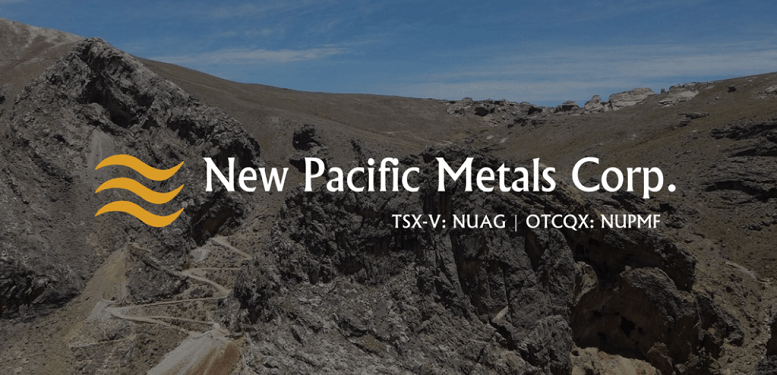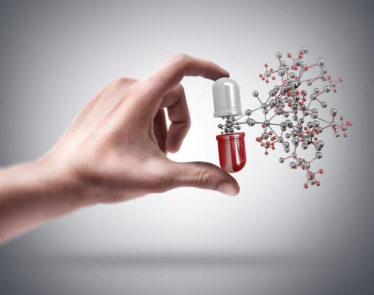
VANCOUVER, British Columbia, Feb. 07, 2019 (GLOBE NEWSWIRE) — New Pacific Metals Corp. (TSXV:NUAG) (OTCQX:NUPMF) (the “Company”) is pleased to announce the preliminary results of the first metallurgical test work for its Silver Sand project in Potosi, Bolivia. Metallurgical sampling and test work commenced in September 2018 – the flotation recovery and bottle roll leaching test works for the transition and sulphide mineralized materials have been completed and test work on the oxides is under way. All tests, including column leaching test works, are expected to be completed by the end of April 2019. Positive recovery results have been achieved in the extraction of silver by the processes of flotation and direct cyanidation from the initial metallurgical test work.
HIGHLIGHTS OF THE PRELIMINARY RESULTS OF COMPLETED TEST WORKS
- Sulphide materials have reported 96.0% silver recovery by rougher-scavenger flotation and the high silver extraction of 96.7% when leached in a bottle-roll with cyanide solution.
- Transition materials achieved 86.8% recovery of silver by flotation and the high extraction of 97.0% by cyanidation in bottle roll test.
- Test results indicate that the sulphide and transition type mineralized materials are non-refractory as per the high silver recoveries achieved during the direct cyanidation at atmospheric pressure.
- The mineralized materials were measured to be mostly in the soft to–medium competent level and abrasion from low-to medium values. Consequently, a lower capital expenditure and operating cost would be required for the comminution circuit.
PROGRAMS OF METALLURGICAL TESTS
Half drilled core samples of oxides, transition and sulphides, representing naturally heterogeneous distribution of oxidation degree, silver grades and lithology of the mineralized materials at the Silver Sand minerals deposit, were collected to produce different composite samples. Four geo-metallurgical test work programs (Mineral Characterization, Comminution, Flotation and Leaching) were developed on these samples. Six metallurgical domains (MET1 to MET6) were identified for the flotation and leaching test work and also six geological domains (GEO1 to GEO6) were branded for the comminution test work. This study methodology has allowed creating ore-specific test works that are producing high silver recovery results at this first stage of the metallurgical program.
Flotation
The test works of flotation were completed by SGS del Peru. Half drilled-core samples were collected to produce three-master composite samples: oxides, transition and sulphides. The flotation program was composed of rougher-scavenger tests at different sizes, a mixture of collectors, collector amount and pH. Collectors from the chemical family of Xanthates, Hydroxamates and Dithiophosphates were tested. They were: PAX (potassium amyl xanthate), SIPX (sodium isopropyl xanthate), DANA468, and OX100.
Eighteen rougher-scavenger flotation tests for the transition (FLOATMET 5 composite) and sulphide (FLOATMET 6 composite) types have been completed. Some of the results are presented in Table 1. Figure 1 shows the flotation cells when transition and sulphide types were processing. Table 1 presents silver and sulphide recoveries after floating for 20 minutes the sulphide and transition materials at specific process conditions. The flotation for the oxide materials is under way.
A photo accompanying this announcement is available at http://www.globenewswire.com/NewsRoom/AttachmentNg/00106821-c3d6-4a17-b7d2-668af2031cb9
The best silver recoveries to the rougher-scavenger concentrate were achieved using PAX as the main collector for both sulphide and transition materials. The silver recovery of 96% was the best result for sulphides materials and 86.8% was for the transition materials. Results so far suggest the use OX100 as a secondary collector to improve silver extraction from transition materials. Similar recoveries were obtained at natural pH and the higher pH of 9. Though the flotation results are promising, they can be optimized at the second stage of the metallurgical test work program.
Table 1. Partial Results for Rougher-Scavenger Test Work
| Type of Materials |
Head Assay | Flotation conditions | Recovered to Concentrate |
||||
| Ag, g/t |
Ssulphide, % |
P80, µm |
Collector | pH | Ag, % |
Ssulphide, % |
|
| Sulphide (FLOATMET 6) |
123 | 1.63 | 74 | PAX, 45g/t | 9 | 96.0 | 98.4 |
| 74 | PAX, 45g/t | natural | 95.5 | 97.2 | |||
| 74 | PAX, 30g/t SIPX, 15g/t |
natural | 94.9 | 97.3 | |||
| 74 | PAX, 30g/t OX100, 15g/t |
natural | 94.8 | 97.3 | |||
| Transition (FLOATMET 5) |
123 | 1.01 | 74 | PAX, 30g/t OX100, 15g/t |
natural | 86.8 | 94.8 |
| 74 | PAX, 45g/t | natural | 85.1 | 92.4 | |||
| 74 | PAX, 45g/t | 9 | 85.2 | 94.8 | |||
| 74 | PAX, 30g/t DANA468, 15g/t |
natural | 85.2 | 93.4 | |||
It is worth mentioning that similar silver recoveries were obtained for the sulphide materials at the particle size of P80 105µm and 74µm; being 92.8% at the biggest material size and 93.8% at 74µm for the flotation of 12 minutes long. These results suggest that the silver minerals seem to be already liberated at the size of 105µm which would give the opportunity to use a smaller comminution circuit.
Bottle Roll Leaching
Four master composite samples were prepared from half drilled cores for the execution of leaching tests with sodium cyanide solution (NaCN) of which one composite sample comprises cores of sulphide materials (LEACHMET 6), the other is made of transition materials (LEACHMET 5) and two composites were composed of oxide materials (LEACHMET 1 and LEACHMET 4).
Direct cyanidation leaching in bottle-roll under conventional and intense conditions has been completed for the sulphide and transition materials. Nineteen tests were carried out considering different materials sizes, cyanide solution strength, air or oxygen sparging and different temperatures. Each bottle roll test was conducted at atmospheric pressure during 72 hours. Some of these leach test results are presented in Table 2.
Bottle roll leaching of oxides is underway at SGS del Peru.
Table 2. Partial Results for Cyanidation Bottle-Roll Leaching
| Type of Materials |
Head Assay | Leaching conditions | Ag Recovery, % |
|||||
| Ag, g/t |
Ssulphide, % |
Cu, % |
P80, µm |
Cyanide Solution Strength, %w/v of NaCN |
Temperature, oC |
Air or Oxygen Sparged |
||
| Sulphide (LEACHMET 6) |
124 | 2.12 | 0.03 | 50 | 0.3 | 57.4 | Oxygen | 96.7 |
| 74 | 0.4 | 29.4 | Oxygen | 94.0 | ||||
| 50 | 0.3 | 26.1 | Oxygen | 93.6 | ||||
| 74 | 0.3 | 29.4 | Oxygen | 92.8 | ||||
| Transition (LEACHMET 5) |
157 | 1.45 | 0.04 | 50 | 0.3 | 56.0 | Oxygen | 97.0 |
| 50 | 0.3 | 25.6 | Oxygen | 94.0 | ||||
| 74 | 0.3 | 28.1 | Oxygen | 93.5 | ||||
| 74 | 0.4 | 29.8 | Oxygen | 93.3 | ||||
High silver extractions of up to 97% were achieved for sulphide and transition materials by intense cyanidation in bottle-rolls using oxygen at 56 – 57oC, as shown in Table 2. None of the samples were pre-treated before the cyanidation; which is an indication of the liberation of the silver grains at the tested materails size and/or low-amount encapsulation in pyrite. Therefore, it can be claimed that the mineralized materials at Silver Sand are non-refractory. The texture and liberation will be confirmed with the QEMSCAN assays that are under way. These leaching results are very encouraging and they could be further improved in the next stage of the metallurgical program.
Column Leaching
The test works of column leaching are in progress at SGS del Peru and are expected to be completed by the end of April 2019.
Comminution
The test works of comminution were completed by SGS del Peru. Four geological domains were tested for Crushing Work Index (CWi), Ball Work Index (BWi) and Abrassion Index (Ai). These domains represent the different rock lithology, type and intensity of alteration and material type that exist at the current drilled area of the Silver Sand deposit.
Twenty-one samples were tested. CWi reported the energy consumption between 4.8 and 11.3kWh/t and the BWi measurements were from 4.8 to 15.9kWh/t, with only one sample above 14 KW/t. Thus, the majority of the samples fell in the category of soft and medium competency level for crushing and grinding. Consequently, a relatively low capital expenditure and operating cost could be expected for the comminution circuit. The Ai reported values between 0.0595 and 0.5363. Oxides and transition materials produced values below 0.3, which corresponds to low abrasion. Sulphide materials reported the highest values in the range of medium abrasion behaviour.
Mineral Characterization
The test works of mineral characterization are being executed by the Research Centre for Mining and Metallurgy (CIMM) and Oruro Technical University (UTO), Bolivia. The mineral characterization and Sink & Float tests are to assess the mineral response to gravity separation. The tests are expected to be complete by the end of February 2019.
The Company is very pleased with the positive results achieved so far from the completed test works. The results suggest that the mineralized materials from Silver Sand project could be amenable for extraction of silver by conventional flotation or direct-intense cyanidation at atmospheric pressure at large scale. This is just the first stage of the metallurgical test work program and silver extraction rates can still be improved by further tuning the parameters of test works.
Technical information contained in this news release and the test programs have been designed and prepared by Mr. Alberto Galvez, an independent consulting metallurgist and a registered member of the Australasian Institute of Mining and Metallurgy (AusIMM) and reviewed and approved by Alex Zhang, P.Geo., Vice President of Exploration of the Company, who is a Qualified Person for the purposes of National Instrument 43-101 – Standards of Disclosure for Mineral Projects (“NI 43-101”).
ABOUT NEW PACIFIC
New Pacific is a Canadian exploration and development company which owns the Silver Sand Project in Potosí Department of Bolivia, the Tagish Lake gold project in Yukon, Canada and the RZY Project in Qinghai Province, China. Its largest shareholders are Silvercorp Metals Inc. and Pan American Silver Corp., one of the world’s largest primary silver producers, which operates six mines, including the San Vicente mine located in the Potosí Department of Bolivia.
For further information, contact:
New Pacific Metals Corp.
Gordon Neal
President
Phone: (604) 633-1368
Fax: (604) 669-9387
[email protected]
www.newpacificmetals.com
Neither the TSX Venture Exchange nor its Regulation Services Provider (as that term is defined in the policies of the TSX Venture Exchange) accepts responsibility for the adequacy or accuracy of this news release.
CAUTIONARY NOTE REGARDING FORWARD-LOOKING INFORMATION
Certain of the statements and information in this press release constitute “forward-looking information” within the meaning of applicable Canadian provincial securities laws. Any statements or information that express or involve discussions with respect to predictions, expectations, beliefs, plans, projections, objectives, assumptions or future events or performance (often, but not always, using words or phrases such as “expects”, “is expected”, “anticipates”, “believes”, “plans”, “projects”, “estimates”, “assumes”, “intends”, “strategies”, “targets”, “goals”, “forecasts”, “objectives”, “budgets”, “schedules”, “potential” or variations thereof or stating that certain actions, events or results “may”, “could”, “would”, “might” or “will” be taken, occur or be achieved, or the negative of any of these terms and similar expressions) are not statements of historical fact and may be forward-looking statements or information.
Forward-looking statements or information are subject to a variety of known and unknown risks, uncertainties and other factors that could cause actual events or results to differ from those reflected in the forward-looking statements or information, including, without limitation, risks relating to: fluctuating equity prices, bond prices, commodity prices; calculation of resources, reserves and mineralization, foreign exchange risks, interest rate risk, foreign investment risk; loss of key personnel; conflicts of interest; dependence on management and others.
This list is not exhaustive of the factors that may affect any of the Company’s forward-looking statements or information. Forward-looking statements or information are statements about the future and are inherently uncertain, and actual achievements of the Company or other future events or conditions may differ materially from those reflected in the forward-looking statements or information due to a variety of risks, uncertainties and other factors, including, without limitation, those referred to in the Company’s Annual Information Form for the year ended June 30, 2018 under the heading “Risk Factors”. Although the Company has attempted to identify important factors that could cause actual results to differ materially, there may be other factors that cause results not to be as anticipated, estimated, described or intended. Accordingly, readers should not place undue reliance on forward-looking statements or information.
The Company’s forward-looking statements or information are based on the assumptions, beliefs, expectations and opinions of management as of the date of this press release, and other than as required by applicable securities laws, the Company does not assume any obligation to update forward-looking statements or information if circumstances or management’s assumptions, beliefs, expectations or opinions should change, or changes in any other events affecting such statements or information. For the reasons set forth above, investors should not place undue reliance on forward-looking statements or information.
CAUTIONARY NOTE TO US INVESTORS
This news release has been prepared in accordance with the requirements of NI 43-101 and the Canadian Institute of Mining, Metallurgy and Petroleum Definition Standards, which differ from the requirements of U.S. Securities laws. NI 43-101 is a rule developed by the Canadian Securities Administrators that establishes standards for all public disclosure an issuer makes of scientific and technical information concerning mineral projects.












